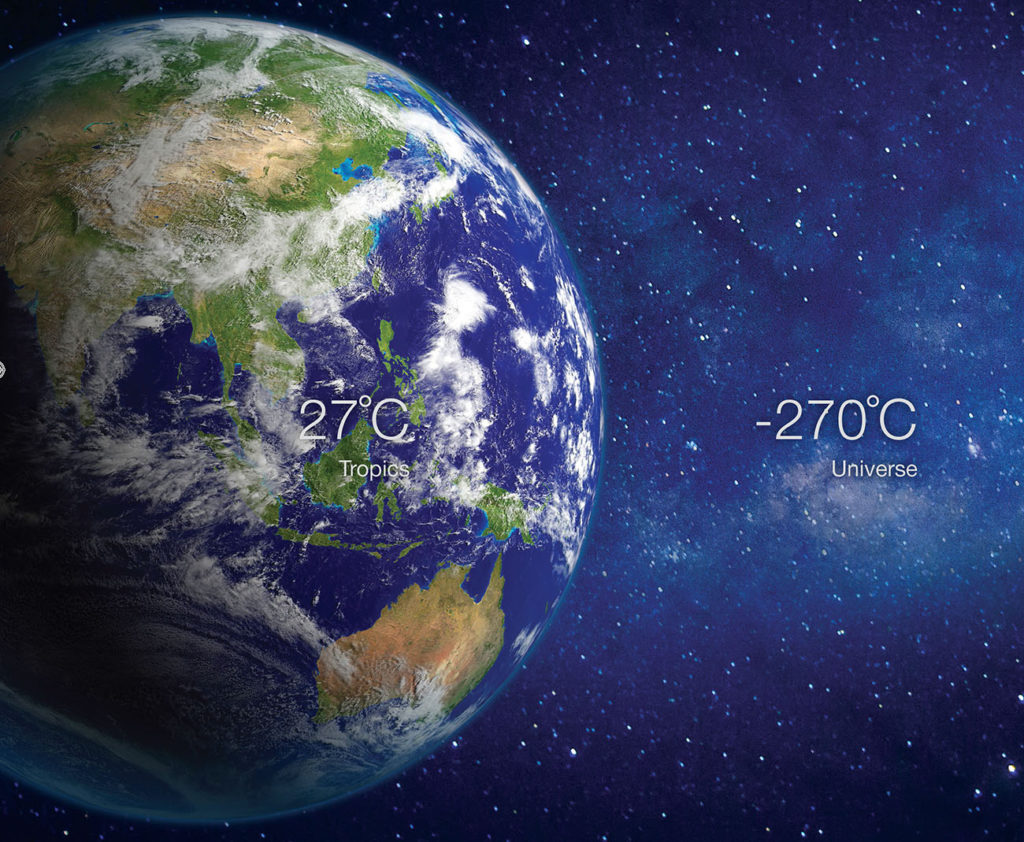The Sky as a Source of Cooling & Other Tropical Innovations
June 15, 2022

Universe versus Earth: Earth’s atmosphere acts as a blanket. Ali Ender Birer/Southtownboy Studio/Shutterstock.com
Do you know that it is possible to produce ice cubes in the tropics (not in the fridge)? Most people are surprised to learn that it is possible by designing with the climate. Last year, our consultancy firm came very close, measuring a temperature below 5 degrees Celsius inside our innovative sky cooling box, which we placed on the roof of our office building in Kuala Lumpur. This article looks at innovative ways to cool and dehumidify, both through passive strategies by taking climatic design to new heights, and by using active cooling techniques.
PASSIVE COOLING
Let us start with the overlooked source of cooling: the tropical sky. As evident from the measurements, the coolest temperatures measured for a naturally ventilated house are on the roof at night. This comes as an eye-opener for most people, as the tropical sky is associated with excessive solar heat, and not as a source of cooling.

Cooltek house in Malaysia: Roof temperature measurements show that the roof at night is about 2 degrees Celsius below the outdoor temperature due to radiation to the cool night sky
Simple sky cooling
For the Earth Berm residential house in Kuala Lumpur, we designed the roof to harvest the free sky cooling at night. The night sky cooling is ‘transported’ into the house by embedding cross-linked polyethylene water pipes, called PEX pipes, into the roof structure. At night, a small pump circulates the water to transport the cooling from the roof into the house below. This closed-loop pipe system does not operate during the day when roof surface temperatures reach as high as 60 degrees Celsius. However, this daytime roof heat could be redirected to deliver free heat to the hot water tank, but that was not done for this particular project.

Earth Berm house in Malaysia: Roof designed for sky cooling harvesting. Photo courtersy of Design Unit Architects
Image courtesy of IEN Consultants
On clear nights without clouds, this sky cooling system can harvest up to 80 watts of cooling per square metre of roof. On average, the cooling effect is about 40 watts per square metre. The cooling effect gradually drops throughout the night, as the indoor floor slabs are cooled down. The sky cooling system requires minimal maintenance, as the pipes embedded in the concrete slab can last 100 years or more.
Advanced sky cooling
The opening image shows that the universe’s temperature is minus 270 degrees Celsius. Earth’s atmosphere acts as a blanket, but how cool is the sky temperature actually? To find out, we pointed our thermographic camera to the tropical sky at night.
RELATED: Project | Daylight Ducts for High-Rise Offices
Interestingly, under clear sky conditions, the sky temperature directly overhead is below 0 degree Celsius. In fact, we have subsequently measured a sky temperature down to minus 22 degrees Celsius in Kuala Lumpur. With such cool sky temperatures overhead, the question arises: Is it possible to harvest this sky cooling more effectively? The answer is yes.
Firstly, it is important to understand the four heat flows that govern the roof temperature at night. The roof is cooled by radiating heat to the cool night sky, which is why the roof temperature drops below the ambient temperature at night. The three heat gains to the roof at night are the convection and conduction from the ambient air, as well as the formation of dew on the roof, once the roof temperature drops below dew point, which typically is around 24 degrees Celsius. The temperature of the roof stabilises once the heat loss and the heat gain level out.
ACTIVE COOLING
The air-conditioning technology used today is surprisingly energy inefficient. Only about 14 per cent of the maximum theoretical efficiency is reached for the most advanced air-conditioners on the market today. Most air-conditioners even have an efficiency of less than 8 per cent. Here, we examine innovative air-conditioning technology with significantly higher energy efficiency.
High temperature cooling
Human comfort in the tropics is achieved at about 24 degrees Celsius. Yet, most cooling systems produce low-temperature chilled water at about 6 degrees Celsius, which significantly reduces the energy efficiency of the cooling system. In several office buildings as well as in the Paramit electronics factory, we have installed a high-temperature cooling system, where 30 to 40 per cent of the cooling is done with chilled water at 17 to 19 degrees Celsius water. Thanks to this high-temperature cooling, the chiller energy efficiency nearly doubles, achieving a coefficient of performance (COP) of 10-11.
[This is an excerpt. Subscribe to the digital edition or hardcopy to read the complete article.]
Gregers Reimann is the managing director for an energy-efficient and healthy building solutions design consultancy IEN Consultants Sdn Bhd based in Malaysia. The goal is to create comfortable and stimulating spaces with contact to nature where people can thrive. Reference projects include the biophilic multi-award winning Paramit – Factory in the Forest and the pioneering GEO Building designed as a zero-energy building. Reimann regularly contributes Green building articles and frequently lectures at universities. He has a keen interest to pursue innovative and integrated design solutions, bridging the gap between architects and engineers.
Read more stories from FuturArc 2Q 2022: New & Re-Emerging Architecture!

To read the complete article, get your hardcopy at our online shop/newsstands/major bookstores; subscribe to FuturArc or download the FuturArc App to read the issues.
Previously Published Commentary
Contact us at https://www.futurarc.com/contact-us for older commentaries.
